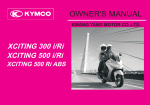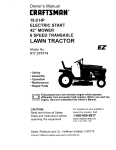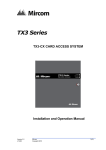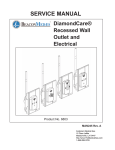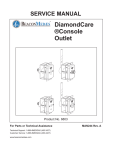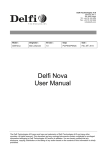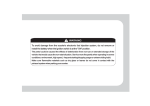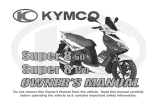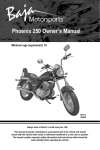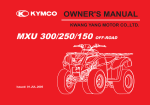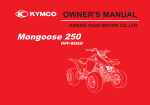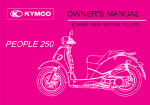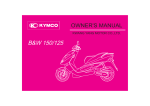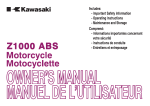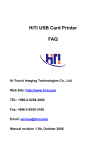Download KYMCO Xciting 250/500 Owner`s Manual (pre 2008
Transcript
OWNER'S MANUAL KWANG YANG MOTOR CO.,LTD. XCITING 500 AFI XCITING 500 XCITING 250 AFI XCITING 250 Issued: 15.02.2006 FOREWORD Thank you for purchasing this KYMCO scooter and welcome to the family of KYMCO scooter riders. Please read this owner's manual carefully before riding so that you will be thoroughly familiar with the proper operation of your scooter controls, its features, capabilities, and limitations. To ensure a long, trouble-free life for your scooter, give it the proper care and maintenance described in this manual. For replacement parts and accessories, we recommend genuine KYMCO products. They've been specially designed for your vehicle and manufactured to meet KYMCO's demanding standards. Keep this owner's manual aboard your scooter at all time so that you can refer to it whenever you need information. This manual should be considered a permanent part of the scooter and should remain with the scooter when it is sold. All information, illustrations, photographs and specifications contained in this manual are based on the latest product information available at the time of publication. Due to improvements or other changes, there may be some discrepancies in this manual. KYMCO reserves the right to make changes at any time without notice and without incurring any obligation. A READ THIS MANUAL CAREFULLY Your Owner's Manual contains important information on safety, operation, and maintenance. Any one who operates this scooter should carefully read and understand the contents of this manual before riding the scooter. SPECIAL MESSAGES Please read this manual and follow its instructions carefully. To emphasize special information the words WARNING , CAUTION and Note carry special meanings and should be carefully reviewed. WARNING CAUTION NOTE: Indicates a strong possibility that serious injury or death may result if instructions are not followed. Indicates a possibility that equipment or property damage could result if instructions are not followed. Gives helpful information The Owner's Manual should be considered a permanent part of your scooter. It should remain with the vehicle at all times and stay with the scooter if it is sold. ON-ROAD USE This scooter is designed to be used only on the road. B CONTENTS Page Page BRAKES.........................................28 SCOOTER SAFETY........................1 FUEL FILL CAP................................30 FRONT SMALL BOX.........................32 CENTER SMALL BOX......................33 SEAT..............................................34 ADJUSTABLE BACKREST...............35 CENTER COMPARTMENT...............36 CENTER COMPARTMENT LIGHT.....37 CELL PHONE SOCKET & CELL PHONE FIXED SEAT.......................37 HELMET HOLDERS........................39 STAND...........................................40 SUSPENSION.................................42 DIAGNOSTIC TOOL CONNECTOR (XCITING 500 AFI/XCITING 250 AFI)..43 IMPORTANT SAFETY INFORMATION................................1 PROTECTIVE APPAREL...................3 LOAD LIMITS AND GUIDELINES.......5 LOCATION OF THE WARNING AND SPECIFICATION LABELS..................8 PARTS LOCATION........................12 FRAME NUMBER............................16 ENGINE NUMBER...........................17 KEY NUMBER.................................18 CONTROLS..................................19 KEYS.............................................19 IGNITION SWITCH..........................19 INSTRUMENT AND INDICATORS....21 RIGHT HANDLEBAR SWITCH..........25 LEFT HANDLEBAR SWITCH............27 PRE-RIDE INSPECTION...............44 OPERATION.................................45 STARTING THE ENGINE.................45 RIDING...........................................50 (Cont'd) C Page Page PARKING........................................55 BREAK-IN (RUNNING IN)................57 COOLANT.......................................85 FRONT AND REAR SUSPENSION INSPECTION..................................87 SIDE STAND...................................88 BRAKE LEVER ADJUSTER.............89 BRAKE FLUID................................89 BRAKE PAD WEAR........................90 PARKING BRAKE OPERATION (XCITING 500 AFI/XCITING 500).......91 BATTERY........................................92 FUSE REPLACEMENT....................94 TIRES............................................97 INSPECTION AND MAINTENANCE............................59 THE IMPORTANCE OF MAINTENANCE..............................59 MAINTENANCE SCHEDULE (XCITING 500 AFI/XCITING 500).......60 MAINTENANCE SCHEDULE (XCITING 250AFI/XCITING 250 )......63 TOOL KIT.......................................66 CRANKCASE BREATHER...............66 ENGINE OIL...................................67 TRANSMISSION OIL.......................76 AIR CLEANER................................78 THROTTLE OPERATION.................81 IDLE SPEED...................................82 SPARK PLUG..................................84 CLEANING.................................101 STORAGE GUIDE.......................106 SPECIFICATIONS (XCITING 500 AFI/XCITING 500)...109 SPECIFICATIONS (XCITING 250AFI/XCITING 250)....111 D SCOOTER SAFETY IMPORTANT SAFETY INFORMATION Your scooter can provide many years of service and pleasure, if you take responsibility for your own safety and understand the challenges that you can meet on the road. There is much that you can do to protect yourself when you ride. You will find many helpful recommendations throughout this manual. Following are a few that we consider most important. Wear a helmet Scooter safety equipment starts with a quality helmet. One of the most serious injuries that can happen is a head injury. Always wear a properly approved helmet. You should also wear suitable eye protection. Make yourself easy to see To make yourself more visible, wear bright reflective clothing, position yourself so other drivers can see you, signal before turning or changing lanes, and use your horn when it will help others notice you. Know your limits Ride within the boundaries of your own skill at all times. Knowing these limits and staying within them will help you to avoid accidents. 1 Keep your scooter in safe condition For safe riding, it's important to inspect your scooter before every ride and perform all recommended maintenance. Never exceed load limits, and only use accessories that have been approved by KYMCO for this scooter. Inspection before riding Do not forget to perform an entire safety inspection to ensure the safety of the rider. Be extra safety conscious on bad weather days Riding on bad weather days, especially wet ones, requires extra caution. Braking distance double on a rainy day. Stay off of the painted surface marks, manhole covers and greasy appearing areas as they can be especially slippery. Use extreme caution at railway crossings and on metal gratings and bridges. Whenever in doubt about road conditions, slow down. M odification Modification of the scooter, or removal of original equipment may render the vehicle unsafe or illegal. Obey all applicable equipment regulations in your area. 2 PROTECTIVE APPAREL For your safety, we strongly recommend that you always wear an approved scooter helmet, eye protection, boots, gloves, long pants, and a long-sleeved shirt or jacket whenever you ride. Helmets and protection Your helmet is your most important piece of riding gear because it offers the best protection against head injuries. A helmet should fit your head comfortably and securely. Always wear a face shield or goggles to protect your eyes and help your vision. Additional riding gear In addition to a helmet and eye protection, we also recommend: Sturdy boots with non-slip soles to help protect your feet and ankles. Leather gloves to keep your hands warm and help prevent blisters, cuts, burns and bruises. A scooter riding suit or jacket for comfort as well as protection. Bright-colored and reflective clothing can help make you more noticeable in traffic. Be sure to avoid loose clothes that could get caught on any part of your scooter. 3 (1) (2) (3) (4) (1)Wear gloves. (2)Clothes should be close-fitting. (3)Always wear an helmet. You should also wear a face shield or goggles. (4)Wear bright or reflective clothing. (5)Shoes should be close-fitting, have low heels and offer ankle protection. WARNING Not wearing a helmet increases the chance of serious injury or death in a crash. Be sure you and your passenger always wear an approved motorcycle helmet that fits properly. You should also wear eye protection and other protective apparel when you ride. (5) 4 LOAD LIMITS AND GUIDELINES These general guidelines may help you decide whether or how to equip your scooter and how to load it safely. Center small box weight limit: 3 kg (6.6 lbs) Load limits Following are the load limits for your scooter: Maximum weight capacity (Includes the weight of the rider, passenger, all cargo and All accessories.): 150 kg (330 lbs) Center compartment weight limit:10 kg (22 lbs) Rear carrier weight limit:5 kg (11 lbs) Maximum cargo weight: 19 kg (42 lbs) Overloading the individual storage compartments can also affect stability and handling. So be sure to stay within the limits given below: Maximum weight: In center compartment In front small box In center small box On rear carrier 10 kg (22 lbs) 1.5 kg (3.3 lbs) 3 kg (6.6 lbs) 5kg (11 lbs) 5 Front small box weight limit: 1.5 kg (3.3 lbs) Loading guidelines Improperly loading your scooter can affect its stability and handling. You should ride at reduced speeds whenever carrying cargo. Follow these guidelines whenever you carry a passenger or cargo: Check that both tires are properly inflated. To prevent loose items from creating a hazard, make sure that all cargo is securely tied down before you ride away Place cargo weight as close to the center of the scooter as possible. Balance cargo weight evenly on both sides. WARNING Overloading or improper loading can cause changes in vehicle handling, stability and braking which could lead to an accident. Never exceed the stated load capacity for this scooter. Cargo should be properly distributed and securely attached. Reduce speed when carrying cargo. Allow greater distance for braking. 6 Accessories and Modification There are great variety of accessories available to KYMCO owners. KYMCO cannot have direct control over the quality or suitability of accessories you may wish to purchase. The addition of unsuitable accessories can lead to unsafe operating conditions. It is not possible for KYMCO to test each accessory on the market or combinations of all the available accessories; however, your dealer can assist you in selecting quality accessories and installing them correctly. Use extreme caution when selecting and installing the accessories for your scooter. WARNING Improper accessories or modifications can make your scooter unsafe and can lead to an accident. Never modify this scooter through improper installation or use of accessories. All parts and accessories added to this vehicle should be genuine KYMCO or equivalent components designed for use on this scooter and should be installed and used according to instruction. If you have question, consult an authorized KYMCO dealer. No modifications We strongly advise you not to remove any original equipment or modify your scooter in any way that would change its design or operation. 7 LOCATION OF THE WARNING AND SPECIFICATION LABELS (1) CAUTIONS Before starting the engine, the side stand shall be kicked up to secure safety. (1) 8 (2): XCITING 500 AFI/XCITING 500 CAUTIONS Every 6000 km run should exchange the filter. (3) CAUTIONS Never put any article between the rear side cover and the engine to avoid interference of riding. (2) (3) 9 (4) (5) (4) ! Be sure to wear a safety helmet when riding. ! Do not exceed the speed specified by law when riding. ! The exhaust muffler temperature is very high after riding. Be sure to park the motorcycle in a place not easily touched by people. ! For riding safety and good performance do not violate the law to modify the motorcycle. ! Make sure to perform the periodic maintenance and preride inspection. ! Preride Inspection Items Brake Performance, tires, engine oil level, lights, horn, and instrument panel. KWANG YANG MOTOR CO., LTD ! Please read the User's Manual carefully to secure driving safely. (5) CAUTIONS Tire Size (One Rider) (Two Rider) Load Capacity : Front 120/70-15 Rear 150/70-14 2 2 : Front 2.00kgf/cm Rear 2.50kgf/cm 2 2 : Front 2.25kgf/cm Rear 2.50kgf/cm : Shield 1.5kg Clip assy center 3kg (As per KYMCO standard specification) 2 (Note: The tire pressure must not overpass 2.50kgf/cm ! Check the motor oil level with the dipstick after refilling motor oil. 10 (7) (6) (6) CAUTION Mobile phone charge only, Use other appliance may cause damage. (7) CAUTION ! ! 11 DON'T WIPE WITH ORGANIC SOLVENT (EX: GAS, THINNER...ETC). USE NEUTRAL SOAP TO CLEAN WINDSHIELD. PARTS LOCATION (06) (05) (04) (03) (02) (01) Fuel fill cap (02) Right rearview mirror (03) Hazard switch/Engine stop switch/Headlight switch/Start button (04) Instruments/Indicators (05) Passing switch/Headlight dimmer switch/Turn signal switch/Horn button (06) Left rearview mirror (07) Left rear suspension spring preload adjuster (08) Right rear suspension spring preload adjuster (01) (07) (08) 12 (12) (11) (10) (09) (09) Center small box (10) Throttle grip (11) Front brake lever (12) Front brake fluid reservoir (13) Rear brake fluid reservoir (14) Rear brake lever (15) Ignition switch (13) (14) (15) 13 (18) (17) (16) (16) Tool kit (17) Center compartment (18) Helmet holder (19) Front small box (20) Coolant level (21) Side stand (22) Center stand (23) Left passenger footpeg (24) Air cleaner (XCITING 500 AFI/ XCITING 500) (25) Air cleaner (XCITING 250 AFI/ XCITING 250) (19) (20) (21) (22) (23) (24) 14 (25) (30) (29) (28) (27) (26) (26) Cell phone fixed seat (27) Center compartment light/Cell phone socket (28) Seat (29) Adjustable backrest (30) Battery/Fuse box/Spare fuses (31) Right passenger footpeg (32) Oil filler cap/Dipstick (33) Parking brake lever (XCITING 500 AFI/ XCITING 500) (31) (32) (33) 15 FRAME NUMBER The read frame number is stamped on right side of the frame. Always check that the frame number stamped on your scooter is the same written in document and warranty scooter is the same written in document and warranty card. Please write down your frame number in place below. FRAME NUMBER: 16 ENGINE NUMBER The engine number is stamped on left engine case. Please write down your engine number in place below. ENGINE NUMBER: 17 KEY NUMBER The key number (1) will be needed when you order replacement part. Record the number for your reference. IGNITION KEY NUMBER: SHUTTER KEY NUMBER: (1) (2) (3) (4) (1) Ignition key number (2) Ignition key (3) Shutter key number (4) Shutter key 18 CONTROLS KEYS This scooter has two ignition switch keys and shutter keys. OPEN OPEN To shut the ignition key-hole shutter with shutter key: Select the shutter key "SHUT" side upward and insert the shutter key into the hole at the ignition switch. OPEN IGNITION SWITCH To open the ignition key-hole shutter with shutter key: Select the shutter key "OPEN" side upward and insert the shutter key into the hole at the ignition switch. SHUT SHUT SHUT NOTE: Apply anti-freeze chemicals when atmospheric Temperature becomes less than freezing point to avoid ignition key-hole shutter freezing. 19 Function “ " Position: All electrical circuits are cut off. The engine will not start. " " Position: The ignition circuit is completed and engine can now be started. The key cannot be removed from the ignition switch. “ " Position: To lock the steering, turn the handlebar all the way to the left. Push down and turn the key to the " " position and remove the key. All electrical circuits are cut off. “ " Position: To open the fuel fill cap, turn the key to the " " position. Make sure that the key is at the " " position when Starting the engine. " " Position: To open the seat, turn the key to the " " position. 20 INSTRUMENT AND INDICATORS (3) (2) (4) (5) (5) (6) (7) (8) (9) (1) Oil Service Mode (21) (20) H (19) (18) (17) (10) M (16) (15) (14) (13) (12) (11) NOTE: The indicator of multi-metee will run from zero to maxi limit then zero when connecting the battery (at the state of ignition switch turn on ) and resetting the position of pointer (if the position of pointer is confused) 21 (1) Oil pressure warning indicator" " Lights when the engine oil pressure is below normal operating range, should light when ignition switch is ON " " and engine is not running. Should go out when the engine starts, except for occasional flickering at or near idling speed when engine is warm. (3) Battery charge telltale If the telltale comes on while driving, this indicates the battery voltage is below 11V. (4) Tachometer Shows engine revolutions per minute (rpm). (5) Right/Left turn signal indicator " " Flashes when the right/left turn signal operates. NOTE: Running the engine with insufficient oil pressure may cause serious engine damage. (6) Speedometer Shows riding speed. (7) Fuel gauge Shows approximate fuel supply available. (2) Mode button The button is used to select the trip meter, the odometer or reset trip meter. 22 (8) Fuel refill Indicator" " Lights when the fuel tank is empty or nearly so and you should refill the tank as soon as possible. (13) Cell phone socket indicator Lights when the cell phone socket is used. (14) Coolant temperature gauge The coolant temperature gauge indicates engine coolant temperature when the ignition switch is in the " " position. (9) Oil service indicator reset button The oil service indicator can be reset by pressing the button when the engine oil has been changed. (15) Minute adjust button Push this button to adjust the minute display. (10) Seat unlock indicator "MET-IN" Lights when the seat is not locked fully. (16) Trip meter/Odometer The display in the speedometer has two functions, trip meter and odometer. The trip meter can register the trip distance. The odometer registers the total distance that the scooter has been ridden. By pressing "(2) Mode button" to select the trip meter (mile or km)or odometer (mile or km). The trip counter can be rest by keeping the button pressed down for more than 2 seconds when the trip counter value is displayed. (11) Side stand down indicator Lights when side stand is left down. (12) High beam indicator Lights when the headlight high beam is turned on. 23 (17) Clock Show hour and minute. (20) CELP: Check engine lamp (XCITING 500 AFI/XCITING 250 AFI) Flashes when there is any abnormality in the CELP system. If it comes on at any other time, reduce speed and take the motorcycle to your KYMCO dealer as soom as possible. (18) Hour adjust button Push this button to adjust the hour display. (19) Oil service indicator If the oil service indicator comes on while driving, this indicates that the engine oil should be changed at each maintenance interval. NOTE: Turn the ignition switch “ON” with no engine speed when the side stand is put up and the engine stop switch is at “ ” (RUN), the CELP will light for two second then off. It shows the lamp work normal. NOTE: The oil service indicator comes on when the vehicle's ignition is turned on and must come off when the engine is running. (21) Parking brake indicator (XCITING 500 AFI/XCITING 500) Lights when the parking brake is applied. 24 RIGHT HANDLEBAR SWITCH Headlight switch (1) " " position The headlight and taillight turn on. " " position The position light and taillight turn on. (1) " " position The headlight and taillight turn off. (2) Electric starter button " " (2) Push in the electric starter button to rotate the starter motor. NOTE: ! If the brake lever is not squeezed, the starter motor will not rotate. ! This scooter is equipped with interlock switches for the ignition circuit and the starter circuit. The engine can only be started if the side stand is fully up. 25 CAUTION To prevent electrical system damage, do not operate the starter motor more than five seconds at a time. Engine stop switch (3) " " position The ignition circuit is off. The engine cannot start or run. (4) " " position The ignition circuit is on and the engine can run. Hazard switch " "(4) " "At this position, the right and left turn signal lights wink together. "OFF"At this position, the right and left turn signal lights go out together. (3) CAUTION ! Turn on hazard switch when parking or there is a special condition. ! After the hazard switch is turned on, it will not reset automatically. Be sure to reset it after use to avoid affecting the traffic safety. ! When the signal lights are winking, the hazard switch does not work. ! When the ignition switch is "OFF", the hazard light will still work. ! If you leave the switch on for a long time, the battery may become totally discharged. So be careful not to use the hazard lights for more than 30 minutes. 26 (1) LEFT HANDLEBAR SWITCH Turn signal switch (1) Use the turn signal switch while turning to another direction or shifting to another lane. The turn signal light will wink when the switch is operated, " " For turning to the "left". " "For turning to the "right". The instrument turn signal indicator light will also wink when the switch is operated. Push the switch and it will release. (2) Horn button " " (2) Press the button to sound the horn. Dimmer switch (3) " " position The headlight low beam and taillight turn on. " "position The headlight high beam and taillight turn on. The high beam indicator light also turns on. Passing light control switch (4) When this switch is pressed, the headlight flashes on to signal approaching cars or when passing. 27 (4) (3) BRAKES Combination brake lever (Left handlebar) The front and rear brakes are applied by squeezing the combination brake lever gently towards the grip. The brake light will be lit when the lever is squeezed inward. Front brake lever (Right handlebar) The brake is applied by squeezing the front brake lever gently towards the grip. The brake light will be lit when the lever is squeezed inward. 28 Parking brake (XCITING 500 AFI/XCITING 500) To apply the parking brake: Pull in the parking brake lever (1) to lock the rear wheel. To apply To release the parking brake: To release the parking brake lever while light pulling in the lever and pushing the release knob (2). Before riding, check that the parking brake indicator is turned OFF and make sure that the rear brake is fully released so there is no drag on the rear wheel. (1) WARNING Riding the scooter with the parking brake lever will be hazardous. The rear brake will overheat and it will reduce braking performance. Operating the parking brake lever while riding can cause rear wheel skid and loss of control. Use the parking brake lever only when parking and release lever before riding. 29 To release (2) FUEL FILL CAP To open the fuel fill cap: Insert the ignition key in the ignition switch and turn it to the " " position (the key can not remove). Rotate the key clockwise to the " " position and open the fuel fill cap (1). Do not overfill the tank. There should be no fuel in the filler neck (2). After refueling, be sure to lock the fuel fill cap firmly. (2) (1) 30 To lock the fuel fill cap: Push fuel fill cap down into place. WARNING Petrol is highly flammable and explosive. You can be burned or seriously injured when handling fuel. ! Stop the engine and keep heat, sparks, and flame away. ! Refuel only out doors. ! Wipe up spills immediately. Fuel recommendation Use unleaded petrol with a research octane number of 91 or higher. Unleaded gasoline can extend spark plug life and exhaust components life. Turn the ignition key from " restarting. " to " " position to 31 FRONT SMALL BOX To open To open: Insert the ignition key (2) and turn it clockwise. To close: 1. Holding the front small box lid (2) closed, turn the ignition key counterclockwise. 2. Remove the key. (1) WARNING Open the box lid while riding can be hazardous. Removing a hand from the handlebars can reduce your ability to control the scooter. To close Always keep both hands on the handlebars during operation. (2) 32 CENTER SMALL BOX To open the box by pull up the lever (2) of the center small box cover (1). To lock the box cover , push down on the box cover until it locks. (1) Pull WARNING Open the box cover while riding can be hazardous. Removing a hand from the handlebars can reduce your ability to control the scooter. Pu sh Always keep both hands on the handlebars during operation. (2) 33 SEAT To unlock the seat " ": (1) Ignition key at the " " position (The engine is running.): Push the key and turn it counterclockwise from " to " " position. (3) (2) " (2) Ignition key at the " " position (The engine is stopped.): Turn it counterclockwise from " " to " " position. (3) Ignition key at the " " position (The steering is locked.): Turn it counterclockwise from " " to " " position. Pull the seat up to lift the seat. To lock seat: Lower and push down on the reverse side of the hooks of the seat until it locks. Make sure the seat is secure before riding. NOTE: The lamplight and "MET-IN" indicator light will come on while the seat is unlock, make sure the seat is locked. 34 PU SH (1) ADJUSTABLE BACKREST The seat is equipped with a backrest (1) which allows the seat to be adjusted according to the riders preference or physical condition. (1) To adjust: Open the seat (see page 34), Pull the locking lever (2) left on the back and move the backrest back and forth according to the riders preference or physical condition. After cleaning or running in the rain, wipe off water collected under the backrest before the scooter again. Pull (2) 35 CENTER COMPARTMENT The center compartment is below the seat. Opening and closing: See "SEAT" (page 34). MAXIMUM WEIGHT LIMIT: 10kg (22 lbs) CAUTION Never exceed the maximum weight limit; handling and stability may be severely affected. The center compartment may become heated by the engine. Do not store food and other articles which are flammable or susceptible to heat damage in this compartment. Do not direct water under pressure against the center compartment as water will be forced into the compartment. 36 CENTER COMPARTMENT LIGHT The center compartment light (1) will be turned ON automatically when the seat is opened. Kept ON as long as the seat is opened regardless of the position of the main switch. (1) CELL PHONE SOCKET & CELL PHONE FIXED SEAT Pull socket cap (2) out and inserting the cell phone charger into the socket. The charging indicator light of instrument will become to red. The socket's rated capacity is DC 12V, 10Watts (0.8A) or less. When you have done using cell phone, unplug it, and cover the socket with cap. This scooter is equipped a cell phone fixed seat (3) which puts the cell phone down at proper position. 37 (3) (2) Operation method Take the fasten band off, then pressing the button to make the pressure plate sprang open. Put the cell phone at proper position on the cell phone fixed seat, then push the pressure plate left. Banding the fasten band, then insert the cell phone charger into the socket. CAUTION ! Do not plug in any heat-generating accessory such as an automobile cigarette lighter because it can damage the socket. ! Do not add electrical equipment that will exceed the accessory socket capacity, otherwise you may blow the fuse (0.8A) in the cell phone socket. ! To avoid the cell phone overcharged, please follow all of the cell phone charger manufacturer's instruments. The quality of the cell phone and the cell phone charger is not guaranteed. (CELL PHONE FIXED SEAT) NOTE: ! The standard accessories of this model don't include the cell phone charger. 38 HELMET HOLDERS To use the helmet holders, unlock the seat (see page 34), hook your helmet fastener ring to the holder and lock the seat securely. WARNING Riding with a helmet attached to the holder can interfere with the rear wheel or suspension and could cause a crash in which you can be seriously hurt or killed. Use the helmet holder only while parked. Do not ride with a helmet secured by the holder. 39 STAND This scooter is equipped with a center stand and side stand. Center stand (1) To place the scooter on the center stand, place your foot on the stand extension and then rock the scooter to the rear and upward with the passenger hand rail with your right hand, while steadying the handlebars with your left hand. (1) Side stand (2) An interlock switch is provided to cut off the ignition circuit when the side stand is down. The side stand down indicator will light when the side stand left down and ignition switch is ON ( ) The side stand/ignition interlock switch works as follows: ! If the side stand is down, the engine can not be started. ! If the engine is running and the side stand is put down, the engine will stop running. 40 (2) WARNING Riding with the side stand incompletely retracted can result in an accident when you turn left. ! Check operation of the side stand/ignition interlock system before riding. ! Always retract the side stand completely before starting off. CAUTION Park the scooter on firm, level ground to help prevent it from falling over. If you must park on an incline, aim the front of the scooter uphill and place the scooter on the center stand, or the scooter on the side stand may roll off, use the parking brake (XCITING 500AFI/XCITING 500)when the scooter is parked with the side stand. 41 SUSPENSION (1) Each shock absorber (1) has 5 adjustment positions for different load or riding conditions. Use a pin spanner (2) to adjust the rear shocks. Always adjust the shock absorber position in sequence (1-2-3-4-5 or 5-4-3-2-1). Attempting to adjust directly from 1 to 5 or 5 to 1 may damage the shock absorber. Position 1 is for light loads and smooth road conditions. Positions 3 to 5 increase spring preload for a stiffer rear suspension, and can be used when the scooter is heavily loaded. Be certain to adjust both shock absorbers to the same position. Standard position: 3 42 (2) 1 2 3 4 1 2 3 5 4 5 DIAGNOSTIC TOOL CONNECTOR (XCITING 500 AFI/XCITING 250 AFI) The diagnostic tool connector (1) located right of the battery in the battery box. We recommend this item be serviced only by your KYMCO dealer. This scooter apply this connector for fuel system condition inspection. Check the fuel system condition using the recommended fuel system tester. 43 (1) PRE-RIDE INSPECTION 3. Coolant level: add coolant if required. Check for leaks (page 85). For your safety, it is very important to take a few moments before each ride to walk around your scooter and check its condition. If you detect any problem, be sure you take care of it, or have it corrected by your KYMCO dealer. 4. Front and rear brakes: check operation; make sure there is no brake fluid leakage (page 89). 5. Tires: check condition and pressure (page 97). WARNING Improperly maintaining this scooter or failing to correct a problem before riding can cause a crash in which you can be seriously hurt or killed. 6. Throttle: check for smooth opening and full closing in all steering positions. 7. Lights and horn: check that headlight, tail/brake light, turn signals, indicators and horn function properly. Always perform a pre-ride inspection before every ride and correct any problems. 8. Engine stop switch: check for proper function (page 26). 1. Engine oil level: add engine oil if required (page 68). Check for leaks. 9. Side stand ignition cut-off system: check for proper function (page 88). 2. Fuel level: fill fuel tank when necessary (page 30). Check for leaks. 10. Steering: check for condition and smoothness. 44 OPERATION STARTING THE ENGINE Always follow the proper starting procedure described below. This scooter is equipped with a side stand ignition cut-off system. The engine cannot be started if the side stand is down. A running engine will shut off if the side stand is lowered. To protect the catalytic converter in your scooter's exhaust system, avoid extending idling and the use of leaded petrol. Your scooter's exhaust contains poisonous carbon monoxide gas. High levels of carbon monoxide can collect rapidly in enclosed areas such as a garage. Do not run the engine with the garage door closed. Even with the door open, run the engine only long enough to move your scooter out of the garage. Do not use the electric starter for more than 5 seconds at a time. Release the starter button for approximately 10 seconds before pressing it again. 45 1. Place the scooter on its center stand and make sure to put the side stand up. 2. Lock the rear wheel by applying the parking brake lever (XCITING 500 AFI/XCITING 500). CAUTION Contact with the spinning rear wheel can cause you to be hurt. Set the parking brake (XCITING 500 AFI/XCITING 500) when the scooter is on its center stand. 46 3. Open the ignition key-hole shutter and make sure the engine stop switch is at " " (RUN). 4. Turn the ignition switch to " " (ON) Confirm the red low oil pressure indicator is ON. The low oil pressure indicator should go off a few seconds after the engine starts. If the light stays on, stop the engine immediately and check the engine oil level. NOTE: Operating the engine with insufficient oil pressure can cause serious engine damage. 5. Squeeze the rear brake lever. The electric starter will only work when the rear brake lever is squeezed and the side stand is up. 47 6. With the throttle closed, push the starter button. Release the starter button as soon as the engine starts. Pu 7. Be sure to keep the throttle closed and the parking brake locked (XCITING 500 AFI/XCITING 500) while warming up the engine. 8. Allow the engine to warm up before riding. Do not "BLIP" the throttle (open and close rapidly) as the scooter will move forward suddenly. Do not leave the scooter unattended while the engine is warming up. 48 Close sh If you cannot restart a warm engine: 1. Place the scooter on its center stand and squeeze the rear brake lever. 2. Open the throttle 1/8 - 1/4 turn while starting the engine. Ignition cut off (XCITING 500 AFI/XCITING 250 AFI) XCITING 500 AFI/XCITING 250 AFI is designed to automatically stop the engine and fuel pump if the scooter is over-turned (a angle detect sensor cuts off the ignition system). Before restarting the engine, you must turn the ignition switch to the OFF position and then back to ON. 49 RIDING Allow the engine oil to circulate before riding Allow sufficient idling time after warm or cold engine start up before applying load or revving the engine. This allows time for the lubricating oil to reach all critical engine components. Review scooter safety (page 1 - 7) before you ride. Make sure flammable materials such as dry grass or leaves do not come in contact with the exhaust system when riding, idling, or parking your scooter. 1. Make sure the throttle is closed and the parking brake (XCITING 500 AFI/XCITING 500) is locked before moving the scooter off the center stand. The rear wheel must be locked when moving the scooter off the center stand or loss of control may result. 50 2. Stand on the left side of the scooter and push it forward and off the center stand. 3. Mount the scooter from the left side keeping at least one foot on the ground to steady the scooter. 51 4. Unlock the rear wheel by releasing the parking brake lever (XCITING 500 AFI/XCITING 500). 5. Before starting off, indicate your direction with the turn signals, and check for safe traffic conditions. Grasp the handlebars firmly with both hands. Never attempt onehanded operation; loss of vehicle control could result. 52 6. To accelerate, open the throttle gradually; the scooter will move forward. Do not "BLIP" the throttle (open and close rapidly) as the scooter will move forward suddenly, causing possible loss of control. Clos e 7. To decelerate, close throttle. Open 8. When slowing down the scooter, coordination of the throttle and front and rear brakes is most important. Both front and rear brakes should be applied together. Independent use of only the front or rear brake reduces stopping performance. Excessive brake application may cause either wheel to lock, reducing control of the scooter. 53 9. When approaching a corner or turn, close the throttle fully and slow the scooter down by applying both front and rear brakes at the same time. 11. When descending a steep grade, close the throttle fully and apply both brakes to slow the scooter. Avoid continuous use of the brakes, which may result in overheating and reduction of braking efficiency. 54 10. After completing the turn, open the throttle gradually to accelerate the scooter. 12. When riding on wet or loose surfaces, be especially cautious. When riding in wet or rainy conditions or on loose surfaces, the ability to maneuver and stop will be reduced. For your safety: ! Exercise extreme caution when braking, accelerating or turning. ! Ride at slower speeds and allow for extra stopping distance. ! Keep the scooter as upright as possible. ! Use extreme caution when riding over slippery surfaces such as railroad tracks, iron plates, manhole covers, painted lines, etc. PARKING 1. After stopping the scooter turn the ignition switch counterclockwise to the " " (OFF) position and remove the key. 2. Use the center stand to support the scooter while parked. Park the scooter on firm, level ground to prevent it from falling over. If you must park on a slight incline, aim the front of the scooter uphill to reduce the possibility of rolling off the center stand or overturning. 55 3. Lock the steering ( see page 20) to help prevent theft. WARNING The exhaust pipe and muffler become very hot during operation and remain sufficiently hot to inflict burns if touched even after shutting off the engine. A hot muffler can burn you. The muffler will be hot enough to burn you for some time after stopping the engine. Make sure flammable materials such as dry grass or leaves do not come in contact with the exhaust system when parking your scooter. PUSH PUSH To lock Park the scooter where pedestrians or children are not likely to touch the muffler. To unlock 56 BREAK-IN (RUNNING-IN) The first 1600 km (1000 miles) are the most important in the life of your scooter. Proper break-in operation during this time will help ensure maximum life and performance from your new scooter. Proper break-in operation allows the machined surfaces to polish each other and mate smoothly. Scooter reliability and performance depend on special care and restraint exercised during the break-in period. It is especially important that you avoid operating the engine in a manner which could expose the engine parts to excessive heat. The following guidelines explain proper break-in procedures. Vary the engine speed The engine speed should be varied and not held at a constant speed. This allows the parts to be "loaded" with pressure, and then unloaded, allowing the parts to cool. This aids the mating process of the parts. It is essential that some stress be placed on the engine components during break-in to ensure this mating process. Do not, though, apply excessive load on the engine. Avoid constant low speed Operating the engine at constant low speed (light load) can cause parts to glaze and not seat in. Allow the engine to accelerate freely through the gears, without exceeding the recommended maximum limits. Do not, however, use full throttle for the first 1600 km (1000 miles). Maximum throttle operation recommendation The maximum recommended throttle operation during the break-in period: Initial 800 km (500 miles): less than 1/2 throttle Up to 1600 km (1000 miles): less than 3/4 throttle 57 Observe your first and most critical service The 1000 km (600 miles) service is the most important service your scooter will receive. During break-in all of the engine components will have worn in and all of the other parts will have seated in. All adjustments will be restored, all fasteners will be tightened, and the dirty oil will be replaced. Timely performance of the 1000 km (600 miles) service will ensure optimum service life and performance from the engine. Breaking in the new tires New tires need proper break-in to assure maximum performance, just as the engine does. Wear in the tread surface by gradually increasing your cornering lean angles over the first 160 km (100 miles) before attempting maximum performance. Avoid hard acceleration, hard cornering, and hard braking for the first 160 km (100 miles). WARNING NOTE: The 1000 km (600 miles) service should be performed as outlined in the maintenance schedule section of this owner's manual. Pay particular attention to the caution and warning in maintenance schedule section. Failure to perform break-in of the tires could cause tire slip and loss of control. Use extra care when riding on new tires. Perform proper break-in of the tires as described in this section and avoid hard acceleration, hard cornering, and hard braking for the first 160 km (100 miles). 58 INSPECTION AND MAINTENANCE WARNING THE IMPORTANCE OF MAINTENANCE A well-maintained scooter is essential for safe, economical and trouble-free riding. It will also help reduce air pollution. Improperly maintaining this scooter or failing to correct a problem before you ride can cause a crash in which you can be seriously hurt or killed. To help you properly care for your scooter, the following pages include a maintenance schedule for regularly scheduled maintenance. Always follow the inspection and maintenance recommendations and schedules in this owner's manual. These instructions are based on the assumption that the scooter will be used exclusively for its designed purpose. Sustained high speed operation or operation in unusually wet or dusty conditions will require more frequent service than specified in the maintenance schedule. Consult your KYMCO dealer for recommendations applicable to your individual needs and use. If your overturns or becomes involved in a crash, be sure your KYMCO dealer inspects all major parts, even if you are able to make some repairs. WARNING Running the engine indoors or in a garage can be hazardous. Exhaust gas contains carbon monoxide, a gas that is colorless and odorless and can cause death or severe injury. Only run the engine outdoors where there is fresh air. 59 MAINTENANCE SCHEDULE (XCITING 500 AFI/XCITING 500) Perform the pre-ride inspection (see page 44) at each scheduled maintenance period. This interval val should be b judged by odometer reading or months, whichever comes first. I: INSPECT ADJUST, LUBRICATE OR REPLACE IF NECESSARY CT AND CLEAN, CL C: CLEAN R: REPLACE A: ADJUST L: LUBRICATE N REP The following wing maintenance mainte ntenance ce schedule sch c edu e specifies all maintenance required to keep your scooter in peak operating ating condition. cond ndition.. Maintenance M Main intenanc work should be performed in accordance with standards and specifications of KYMCO KYMC MCO O by properly prop prope p y trained and equipped technicians. Your KYMCO dealer meets requirements. ement nts. eets all of these t *Should be ur KYMCO KYMC b serviced by your YMCO CO dealer, unless the owner has the proper tools and service data and is mechanically qualified. me mechan ** these items be serviced only by your KYMCO dealer. *In the interest in st of safety, s y, we recommend ite mmend th KYMCO your dealer YMCO recommends reco ecommen endss that t you KYMCO oad test yyour scooter after each periodic CO d ler should road maintenance ce is carried carr arried d out.. NOTE: 1 At higher odometer readings, interval gs, repeat at at the frequency f val established esta tablishe here. dings, 2 Service more frequently if the scooter scoote ter is ridden ridd in unusually wet or dusty dustty areas. 3 Service more frequently when hen riding g in rain orr at full throttle. t 4 Inspect every 18000 km (12000 mi)) after replacement. re lacemen ment. 5 Replace every 1 year, or every 10000km (6000mi), comes first. 00mi),, whichever w which placement ment nt requires re requi irst. Replacement Rep mechanical skill. 6 Replace every 2 year, or at indicated odometer interval, comes first. Replacement erval, whichever whiche aceme ement requires mechanical skill. 7 Replace every 2 years. Replacement requires mechanical cal skill. skill 60 FREQUENCY ITEM AIR CLEANER SPARK PLUGS * THROTTLE OPERATION * VALVE CLEARANCE * FUEL LINE CRANKCASE BREATHER ENGINE OIL ENGINE OIL FILTER * ENGINE OIL STRAINER SCREEN * ENGINE IDLE SPEED RADIATOR COOLANT * COOLING SYSTEM * SECONDARY AIR SUPPLY SYSTEM WHICHEVER ODOMETER READING [NOTE (1)] COMES FIRST X 1000 km 1 6 12 18 24 30 36 REFER X 1000 mi 0.6 4 8 12 16 20 24 TO PAGE 6 12 18 24 30 36 MONTH NOTE NOTE 2 R R R R R R 78~79 R R R I C R R I C R R 66 67~75 71~75 R R C R R C R R C C C C C C C 71~75 I I I I I I I I I I I R I 82 85~87 - I - I 61 81 - I C R R NOTE 3 NOTE 6 I I I I C R R I FREQUENCY ITEM * TRANSMISSION OIL * DRIVE BELT ** CLUTCH SHOE WEAR BRAKE FLUID BRAKE PAD WEAR BRAKE SYSTEM * BRAKE LIGHT SWITCH * BRAKE LOCK OPERATION SIDE STAND * SUSPENSION * HEADLIGHT AIM * NUTS, BOLTS, FASTENERS ** WHEELS/TIRES ** STEERING BEARINGS WHICHEVER ODOMETER READING [NOTE (1)] COMES FIRST X 1000 km 1 6 12 18 24 30 36 REFER X 1000 mi 0.6 4 8 12 16 20 24 TO PAGE 6 12 18 24 30 36 NOTE MONTH NOTE 5 76 R NOTE 4 I I I I I I I I I I I R I I NOTE 7 89 90 I I I I I I I I I I 89~91 I I I I I I 62 I I I I I I I I I I I I I I I I I I I I I I I I 91 88 87 - MAINTENANCE SCHEDULE CHEDULE (XCITING 250AFI/XCITING 250) Perform the pre-ride e inspection inspectio (see page 44) at each scheduled maintenance period. This interval should d be judged judge reading or months, whichever comes first. ged by odometer o I: INSPECT AND CLEAN, ADJUST, AD OR REPLACE IF NECESSARY ADJUST ST, LUBRICATE LU C: CLEAN R: REPLACE EPLACE ADJUST L: LUBRICATE E A A: ADJ DJUST The following maintenance e schedule schedu dule sspecifies specifie cifies all maintenance required to keep your scooter in peak operating Maintenance be nancce workk should s ting condition. condit b performed in accordance with standards and specifications perly tra y trained train cations of KYMCO by properly ained and equipped technicians. Your KYMCO dealer meets all off these requirements. req equirem *Should be serviced owner has the proper tools and service data service iced byy your y ur KYMCO KYMC dealer, ss the ow ler, unless and is mechanically mechanica cally qualified. qua ualifie fied. **In the interest of safety safety, ety, we w recommend reco ecomm ommend tthese items ced only by your KYMCO dealer. tems be serviced KYMCO recommends thatt your dealer should road test ur KYMCO KYMC YMCO CO deale st yourr scooter sscoote oter after afte each periodic maintenance is carried out. NOTE: 1 At higher odometer readings, repeat at the established here. e frequency frequen ncy interval inter ere. 2 Service more frequently if the scooter is ridden dd in i unusually unusuall eas. ally wet or dusty areas. 3 Service more frequently when riding in rain or at full ull throttle. throttl ttle. 4 Clean every 2000 km (1200 mi) after replacement and replace 5000 km (3000 mi). rep eplace e e every 5 Replace every 1 year, or every 4000km (2400mi), whichever ever comes com first. Replacement requires uires mechanical skill. 6 Replace every 10000 km (6000 mi), or once a year it at every 5000 km (3000 mi). Replacement requires mechanical skill. 7 Replace every 2 years. Replacement requires mechanical skill. 63 FREQUENCY ITEM * AIR CLEANER SPARK PLUGS * THROTTLE OPERATION * VALVE CLEARANCE * FUEL LINE CRANKCASE BREATHER ENGINE OIL * ENGINE OIL STRAINER SCREEN * ENGINE IDLE SPEED RADIATOR COOLANT * COOLING SYSTEM * SECONDARY AIR SUPPLY SYSTEM WHICHEVER ODOMETER READING [NOTE (1)] COMES FIRST X 1000 km 0.3 1 3 5 7 9 11 REFER X 1000 mi 0.2 0.6 1.8 3 4.2 5.4 6.6 TO PAGE 3 6 12 18 24 30 MONTH NOTE NOTE 2 I R I R I R 80 R R R R NOTE 4 81 I I A A A A I I 66 NOTE 3 C C C C C C R C NOTE 6 64 R R R R R R 67~75 C C C 71~75 I I I R I I 82 85~87 - I I - FREQUENCY ITEM * TRANSMISSION OIL * DRIVE BELT ** CLUTCH SHOE WEAR BRAKE FLUID BRAKE PAD WEAR BRAKE SYSTEM * BRAKE LIGHT SWITCH SIDE STAND * SUSPENSION * HEADLIGHT AIM * NUTS, BOLTS, FASTENERS ** WHEELS/TIRES ** STEERING BEARINGS WHICHEVER ODOMETER READING [NOTE (1)] COMES FIRST X 1000 km 0.3 1 3 5 7 9 11 REFER X 1000 mi 0.2 0.6 1.8 3 4.2 5.4 6.6 TO PAGE 3 6 12 18 24 30 NOTE MONTH NOTE 5 76 R R R R I I I I I I R NOTE 7 89 90 I I I I I I I I I I I I 89~91 I I I I I 65 I I I I I I I I I I I I I I I 88 87 - TOOL KIT To assist you in the performance of periodic maintenance, a tool kit (1) is supplied and located under the seat (see page 34). (1) CRANKCASE BREATHER 1. Remove the crankcase breather tube plug (2) from the tube and drain deposits into a suitable container. 2. Reinstall the crankcase breather tube plug. Service more frequently when riding in rain, at full throttle, or after the scooter is washed or overturned. Service if the deposit level can be seen in the transparent section of the drain tube. (2) 66 ENGINE OIL Engine oil recommendation Use a premium quality 4-stroke motor oil to ensure longer service life of your scooter. Use only oils which are rated, SJ under the API service classification. The recommended viscosity is SAE 5W-50. If a SAE 5W-50 motor oil is not available, select an alternative according to the right chart. OIL VISCOSITIES 10W 10W 20W 20W Single Garde 20 30 40 Oil capacity: see page 109 or 111 20W-40 , 20W-50 20W-50 20W-40, 15W-40 , 15W-50 15W-50 15W-40, Multi Garde 10W-40 10W-40 10W-30 10W-30 20W-40 5W-50 , 20W-50 -10 0 67 20 0 10 40 20 60 30 80 0 40 C 0 100 F Engine oil level check Check the engine oil level each day before riding the scooter. The level must be maintained between the upper (1) and lower level (2) marks on the oil filler cap/dipstick. 1. Start the engine and let it idle for a few minutes. Make sure the red low oil pressure indicator goes off. If the light remains on, stop the engine immediately. 2. Stop the engine and put the scooter on its center stand on level ground. 3. After a few minutes, remove the oil filler cap/dipstick, wipe it clean, and reinsert the oil filler cap/dipstick without screwing it in. Remove the oil filler cap/dipstick. The oil level should be between the upper and lower marks on the oil filler cap/dipstick. 4. If required, add the specified oil (see page 67) up to the upper level mark. Do not overfill. 5. Reinstall the oil filler cap/dipstick. Check for oil leaks. NOTE: ! Running the engine with insufficient oil pressure may Cause serious engine damage. ! Let the engine and exhaust system cool before working in those areas. 68 (1) (2) Engine oil replacement Engine oil quality is the chief factor affecting engine service life. Change the engine oil as specified in the maintenance schedule (see page 60 or 63). When running in very dusty conditions, oil changes should be performed more frequently than specified in the maintenance schedule. Please dispose of used engine oil in a manner that is compatible with the environment. We suggest you take it in a sealed container to your local recycling center or service station for reclamation. Do not throw it in the trash or pour it on the ground or down a drain. Used engine oil may cause skin cancer if repeatedly left in contact with the skin for prolonged periods. Although this is unlikely unless you handle used oil on a daily basis, it is still advisable to thoroughly wash your hands with soap and water as soon as possible after handling used oil. Change the engine oil with the engine at normal operating temperature and the scooter on its center stand to assure complete and rapid draining. 1. Remove the oil filler cap/dipstick (1) from the right crankcase cover. 2. Place a container under the left crankcase. 69 (1) 3. Remove the oil drain plug (2) to drain the oil. 4. Reinstall the drain plug and tighten the drain plug to specification. Oil drain plug torque: 25 N-m (2.5 kgf-m, 18lbf-ft) 5. Fill the engine with oil and install the oil fill cap. Oil capacity (after draining): XCITING 500 AFI/XCITING 500: 2.0 liter (2.1 US qt, 1.8 lmp qt) XCITING 250 AFI/XCITING 250: 0.9 liter (0.95 US qt, 0.8 lmp qt) 6. Start the engine and let it idle for 2-3 minutes. 7. Stop the engine and check that the oil level is at the upper level mark on the oil filler cap/dipstick with the scooter upright on firm, level ground. Make sure there are no oil leaks. NOTE: ! Running the engine with insufficient oil pressure may cause serious engine damage. ! Let the engine and exhaust system cool before working in those areas. (2) 70 Oil filter cartridge (XCITING 500 AFI/XCITING 500)and Oil strainer screen Changing the oil filter cartridge requires a special oil filter cartridge tool and a torque wrench. If you do not have these tools and the necessary skill, we recommend that you have your KYMCO dealer perform this service. If a torque wrench is not used for this installation, see your KYMCO dealer as soon as possible to verify proper assembly. Change the engine oil with the engine at normal operating temperature and the scooter on its center stand to assure complete and rapid draining. NOTE: ! Running the engine with insufficient oil pressure may cause serious engine damage. ! Let the engine and exhaust system cool before working in those areas. 1. Remove the oil filler cap/dipstick (1) from the right crankcase cover. 71 (1) 2. Place a drain pan under the crankcase and remove the oil strainer screen cap (2). The spring (3) and oil strainer screen (4) will come out when the drain plug is removed. 3. Clean the oil strainer screen. 4. Check that the oil strainer screen, sealing rubber and drain plug O-ring are in good condition. (2) (4) (3) (2) 72 5. XCITING 500 AFI/XCITING 500: Remove the rubber sleeve (5) by removing the clip (6). XCITING 500 AFI/XCITING 500 (5) 6. XCITING 500 AFI/XCITING 500: Remove the oil filter cartridge (7) with a filter wrench and let the remaining oil drain out. Discard the oil filter cartridge. XCITING 500 AFI/XCITING 500 (7) 73 (6) 7. XCITING 500 AFI/XCITING 500: Apply a thin coat of engine oil to the new oil filter cartridge rubber seal (8). 8. XCITING 500 AFI/XCITING 500: Using a special tool and a torque wrench, install the new oil filter cartridge and tighten to a torque of: 12 N-m (1.2 kgf-m, 8 lbf-ft) Use only the KYMCO genuine oil filter cartridge or a filter cartridge of equivalent quality specified for your model. Using the wrong KYMCO filter cartridge or a non-KYMCO filter cartridge which is not of equivalent quality may cause engine damage. 74 XCITING 500 AFI/XCITING 500 (8) XCITING 500 9. Install the oil strainer screen, spring and oil strainer screen cap. Oil strainer screen cap torque: 15 N-m (1.5 kgf-m, 11 lbf-ft) 10. Fill the crankcase with the recommended grade oil (see page 67). Oil capacity (after draining and oil filter change): XCITING 500 AFI/XCITING 500: 2.1 liter (2.2 US qt, 1.9 lmp qt) XCITING 250 AFI/XCITING 250: 0.9 liter (0.95 US qt, 0.8 lmp qt) 11. Install the oil filler cap/dipstick. 12. Start the engine and let it idle for 2-3 minutes. 13. Stop the engine and check that the oil level is at the upper level mark on the oil filler cap/dipstick with the scooter upright on firm, level ground. Make sure there are no oil leaks. 75 TRANSMISSION OIL Oil change XCITING 500 AFI/XCITING 500 1. Place the scooter in its center stand. 2. Remove the transmission oil drain bolt (1). (1) XCITING XCITING 250 250/XCITING 250 AFI (1) 76 3. Remove the transmission oil filler bolt (2), slowly turn the rear wheel and drain the oil. After draining the oil completely, install the oil drain bolt with a new sealing washer and tighten it. XCITING 500 AFI/XCITING 500 Torque: 20 N-m (2 kgf-m, 15 lbf-ft) 4. Fill the transmission case with recommended oil. (2) Recommended transmission oil: SAE 90 Oil capacity (at draining): XCITING 500 AFI/XCITING 500: 0.45 liter (0.48 US qt, 0.4 lmp qt) XCITING 250 AFI/XCITING 250: 0.18 liter (0.2 US qt, 0.16 lmp qt) XCITING 250/XCITING 250 AFI 5. Install the transmission oil filler bolt with a new sealing washer and tighten it. Torque: 20 N-m (2 kgf-m, 15 lbf-ft) 77 (2) AIR CLEANER The air cleaner should be serviced at regular intervals. Service more frequently when riding in unusually wet or dusty areas. Push Air cleaner element (XCITING 500 AFI/XCITING 500): 1. Open seat (see page 34) 2. Remove air cleaner cover (1). (1) 3. Remove the screws and air cleaner case cover (2) (2) 78 Push 4. Remove the air cleaner element (3) by pull it out. 5. Discard the air cleaner element. 6. Install a new air cleaner element. Use the KYMCO genuine air cleaner element or an equivalent air cleaner element specified for your model. Using the wrong KYMCO air cleaner element or a non-KYMCO air cleaner element which is not of equivalent quality may cause premature engine wear or performance problems. 7. Install the removed parts in the reverse order of removal. 79 (3) Air cleaner element (XCITING 250/XCITING 250 AFI): The air cleaner element (1) should be replaced by a KYMCO dealer, unless the owner has proper tools and service data and is mechanically qualified. Use the KYMCO genuine air cleaner element or an equivalent air cleaner element specified for your model. Using the wrong KYMCO air cleaner element or a non-KYMCO air cleaner element which is not of equivalent quality may cause premature engine wear or performance problems. (1) 80 THROTTLE OPERATION 1. Check for smooth rotation of the throttle grip from the fully open to the fully closed position at both full steering positions. 2. Measure the throttle grip free play at the throttle grip flange. The standaard free play should approximately: 2-6 mm (0.08-0.24 in) 2-6 mm (0.08-0.24 in) To adjust the free play: 1. Slide the rubber sleeve (1) back to expose the throttle cable adjuster (2). 2. Loosen the lock nut (3), then turn the adjuster to obtain the correct free play. 3. Tighten the lock nut and reinstall the sleeve. 81 (3) (2) (1) IDLE SPEED The engine must be at normal operating temperature for accurate idle speed adjustment. Ten minutes of stop-andgo riding is sufficient. 1. Warm up the engine place the scooter on its center stand. 2. Open the seat (see page 34). 3. Open the carburetor cover (1). 82 (1) Push 4. Adjust idle speed with the throttle stop screw (2). XCITING 500 Idle speed: XCITING 500: 1400 100 rpm XCITING 250: 1700 100 rpm NOTE: It is not necessary to adjust idle speed for XCITING 250 AFI. The throttle body is factory pre-set, do not loosen or tighten the painted bolts and screws of the throttle body. Lossening or tightening them can cause throttle and idle valve synchronization failure. We recommend the AFI (automatic fuel injection) system be serviced only by your KYMCO dealer. (2) XCITING 250 Idle speed: XCITING 500 AFI: 1400 100 rpm XCITING 250 AFI: 1600 100 rpm (2) 83 SPARK PLUG Remove the carbon deposits from the spark plug with a small wire brush or a spark plug cleaning machine. Readjust the spark plug gap to specified limit by using a spark plug gap thickness gauge. The spark plug should be replaced periodically. Whenever removing the carbon deposits, be sure to observe the operational color of the spark plug's porcelain tip. This color tells you whether or not the standard spark plug is suitable for your type of usage. A normal operating spark plug should be light brown or tan color. If the spark plug is very white or glazed appearing, then it has been operating much too hot. This spark plug should be replaced with the colder plug. CAUTION An improper spark plug may have an incorrect fit or heat range for your engine. This may cause severe engine damage which will not be covered under warranty. XCITING 500 AF/500: 0.6 - 0.7 mm (0.024 - 0.028 in) Never use a spark plug with an improper heat range. Severe engine damage could result. XCITING 250 AFI/250: 0.8 - 0.9 mm (0.032 - 0.036 in) Recommended plug: XCITING 500 AFI: CR7E XCITING 500: CR8E XCITING 250: DPR7EA-9 XCITING 250 AFI: DPR6EA-9 84 COOLANT Inspection The reserve tank is under footboard left. Check the coolant level through the inspection window (1) at the left side skirt while the engine is at the normal operating temperature with the scooter in an upright position. If the coolant level is below the LOWER level mark (3), remove the left floor mat (4) and remove screw (5) and reserve tank lid (6) and reserve tank cap (7) and add coolant mixture until it reaches the upper level mark (2). Always add coolant to the reserve tank. Do not attempt to add coolant by removing the radiator cap. (1) (2) F (3) (7) (6) L (5) (4) If the reserve tank is empty, or if coolant loss is excessive, check for leaks and see your KYMCO dealer for repair. 85 Coolant recommendation The owner must properly maintain the coolant to prevent freezing, overheating, and corrosion, use only high quality ethylene glycol antifreeze containing corrosion protection inhibitors specifically recommended for use in aluminum engines.(See antifreeze container label.) Use only low-mineral drinking water or distilled water as a part of the antifreeze solution. Water that is high in mineral content or salt may be harmful to the aluminum engine. Using coolant with silicate inhibitors may cause premature wear of water pump seals or blockage of radiator passages. Using tap water may cause engine damage. The factory provides a 50:50 solution of antifreeze and distilled water in this scooter. This coolant solution is recommended for most operating temperatures and provides good corrosion protection. Coolant replacement Coolant should be replaced by a KYMCO dealer, unless the owner has proper tools and service data and is mechanically qualified. Always add coolant to the reserve tank. Do not attempt to add coolant by removing the radiator cap. WARNING Removing the radiator cap while the engine is hot can cause the coolant to spray out, seriously scalding you. Always let the engine and radiator cool down before removing the radiator cap. 86 FRONT AND REAR SUSPENSION INSPECTION A higher concentration of antifreeze decreases the cooling system performance and is recommended only when additional protection against freezing is needed. A concentration of less than 40:60 (40% antifreeze) will not provide proper corrosion protection. During freezing temperatures, check the cooling system frequently and add higher concentrations of antifreeze (up to a maximum of 60% antifreeze) if required. 1. Check the fork assembly by locking the front brake and pumping the fork up and down vigorously. Suspension action should be smooth and there must be no oil leakage. 2. Swing arm bearings should be checked by pushing hard against the side of the rear wheel while the scooter is on the center stand. Free play indicates worn bearings. 3. Carefully inspect all front and rear suspension fasteners for tightness. 87 SIDE STAND Perform the following maintenance in accordance with the maintenance schedule. Functional check: ! Check the spring for damage or loss of tension and the side stand assembly for freedom of movement. ! Check the side stand ignition cut-off system: 1. Place the scooter on its center stand. Side stand up 2. Put the side stand up and start the engine. 3. Lower the side stand. The engine should stop as you put the side stand down. If the side stand system does not operate as described, see your KYMCO dealer for service. Side stand down 88 BRAKE LEVER ADJUSTER There is an adjuster on both the brake levers. Each adjuster has 4 positions so that the released lever position can be adjusted to suit the operator's hands. (3) Push the lever (1) forward and turn the adjuster (2) to align the number with the arrow mark (3) on the lever holder. The distance from the grip to the released lever is minimum at number 4 and maximum at number 1. (2) P us h BRAKE FLUID Brake fluid level: With the scooter in an upright position, check the front and rear fluid level. It should be above the lower level mark. If the level is at or below the lower level mark "L", check the brake pads for wear (see page 90). Worn pads should be replaced. If the pads are not worn, have your brake system inspected for leaks. The recommended brake fluid is DOT 4 brake fluid from a sealed container, or an equivalent. Other checks: Make sure there are no fluid leaks. Check for deterioration or cracks in the hoses and fittings. 89 (1) L BRAKE PAD WEAR Brake pad wear depends upon the severity of usage, the type of riding, and road conditions. (Generally, the pads will wear faster on wet and dirty roads.) Inspect the pads at each regular maintenance interval. Front right/left brake Check the cutout in each pad. If either pad is worn to the cutout, replace both pads as a set. See your KYMCO dealer for this service. Rear brake Check the cutout in each pad. If either pad is worn to the cutout, replace both pads as a set. See your KYMCO dealer for this service. 90 PARKING BRAKE OPERATION (XCITING 500 AFI/XCITING 500) Parking brake inspection: 1. Stop the engine and put the scooter on its center stand on level ground. 2. Pull the parking brake lever slowly and check the lever stroke. Standard: 3-6 notches If adjustment is necessary, have the brake adjusted by our KYMCO dealer for this service. 91 BATTERY It is not necessary to check the battery electrolyte level or add distilled water as the battery is a maintenance-free (sealed) type. If your battery seems weak and/or is leaking electrolyte (causing hard starting or other electrical troubles), contact your KYMCO dealer. NOTE: Your battery is a maintenance-free type and can be permanently damaged if the cap strip is removed. WARNING The battery gives off explosive hydrogen gas during normal operation. A spark or flame can cause the battery to explode with enough force to kill or seriously hurt you. Wear protective clothing and a face shield, or have a skilled mechanic do the battery maintenance. 92 Battery removal (Always keep ignition switch is OFF) The battery is in the battery box below seat. (1) 1. Open the seat (see page 34). 2. Remove the screws (1) and battery cover (2). (2) 3. Remove the battery retainer (3). 4. Disconnect the negative (-) terminal lead (4) from the battery first, then disconnect the positive (+) terminal lead (5). 5. Pull out the battery from the battery box. Battery installation: Install in the reverse order of the removal. (5) 93 (3) (4) FUSE REPLACEMENT When frequent fuse failure occurs, it usually indicates a short circuit or an overload in the electrical system. See your KYMCO dealer for repair. NOTE: Never use a fuse with a different rating from that specified. Serious damage to the electrical system or a fire may result, causing a dangerous loss of lights or engine power. Fuse list ! 30A CHARGE fuse protects battery charging system. ! 15A MAIN fuse protects all electrical circuits. ! 15A HEAD-HI/LO fuse protects the headlight high/lower beam and high beam indicator light. ! 10A IGNITION fuse protects the ignition system. ! 10A FAN fuse protects the cooling fan motor. 94 Blown fuse Fuse box : The fuse box is located left side of the battery in the battery box . The specified fuses (2) are: 10A, 15A 1. Open the seat (see page 34). 2. Open the battery cover.(see page 93). (1) 3. Open the fuse box cover (1). 4. Pull out the old fuse and install a new fuse. The spare fuse (3) are located in the battery retainer. (3) 5. Close the fuse box covers and seat. (2) 95 Charge fuse : The charge fuse is located right side of the battery in the battery box . The specified fuses (2) are: 30A (1) 1. Open the seat (see page 34). 2. Remove the battery (see page 93). 3. Disconnect the wire connector (1) of the starter magnetic switch. 4. Pull out the old fuse and install a new fuse. The spare fuse are located in the battery retainer. 5. Reconnect the connector. 96 (2) TIRES WARNING WARNING Failure to perform break-in of the tires could cause tire slip and loss of control. Failure to follow these warnings may result in an accident due to tire failure. The tires on your scooter form the crucial link between your scooter and the road. Use extra care when riding on new tires. Perform proper break-in of the tires referring to the break-in section and avoid hard acceleration, hard cornering, and hard braking for the first Follow these instructions: ! Check tire condition and pressure, and adjust pressure before each ride. ! Avoid overloading your scooter. ! Replace a tire when worn to the Check the tire inflation pressure and tire tread condition at the periodic inspection. For maximum safety and good tire life, the tire pressures should be inspected more often. specified limit, or if you find damage such as cuts or cracks. ! Always use the size and type of tires specified in this owner's manual. ! Balance the wheel after tire installation. ! Read this section of owner's manual carefully. 97 Tire tread condition Proper tire condition and proper tire type affect vehicle performance. Cuts or cracks in the tires can lead to tire failure and loss of vehicle control. Worn tires are susceptible to puncture failures and subsequent loss of vehicle control. Tire wear also affects the tire profile, changing vehicle handling characteristics. Tire pressure Insufficient air pressure in the tires not only hastens tire wear but also seriously affects the stability of the scooter. Under inflated tires make smooth cornering difficult and overinflated tires decrease the amount of tire in contact with the ground which can lead to skids and loss of control. Be sure that the tire pressure is within the specified limits at all times. Tire pressure should only be adjusted when the tires are cold. Cold inflation tire pressure Solo riding Two-up riding Front 200 kpa 2 (2 kgf/cm , 29 psi) 225 kpa 2 (2.25 kgf/cm , 32 psi) Rear 250 kpa 2 (2.5 kgf/cm , 36 psi) 250 kpa 2 (2.5 kgf/cm , 36 psi) Check tire conditions each day before you ride. Replace tires if tires show visual evidence of damage, such as cracks or cuts, or if tread depth is less than 1.6 mm (0.06 in) front, 2.0 mm (0.08 in) rear. NOTE: These wear limits will be reached before the wear bars molded into the tire make contact with the road. 98 When you replace a tire, be sure to replace it with a tire of the size listed below. If you use a different size of tire, scooter handling may be adversely affected, possibly resulting loss of scooter control. Front Rear Size 120/70-15 150/70-14 Type TUBELESS TUBELESS WARNING An improperly repaired, installed, or balanced tire can cause loss of control or shorten tire life. ! Ask your KYMCO dealer or qualified mechanic to perform tire repair, replacement, and balancing because proper tools and experience are required. ! Install tires according to the rotation direction shown by arrows on the sidewall of each tire. Be sure to balance the wheel after repairing a puncture or replacing the tire. Proper wheel balance is important to avoid variable wheel-toroad contact, and to avoid uneven tire wear. 99 WARNING Failure to follow these instructions about tubeless tires may result in an accident due to tire failure. Tubeless tires require different service procedures than tube tires. ! Tubeless tires require an air-tight seal between the tire bead and wheel rim. Special tire irons and rim protectors or a specialized tire mounting machine must be used for removing and installing tires to prevent tire or rim damage which could result in an air leak. ! Repair puncture in tubeless tires by removing the tire and applying an internal patch. ! Do not use an external repair plug to repair a puncture since the plug may work loose as a result of the cornering forces experienced in a scooter tire. ! After repairing a tire, do not exceed 80 km/h (50 mph) for the first 24 hours, 130 km/h (80 mph) thereafter. This is to avoid excessive heat build-up which could result in a tire repair failure and tire deflation. ! Replace the tire if it is punctured in the sidewall area, or if a puncture in the tread area is larger than 6 mm (3/16 in). These punctures cannot be repaired adequately. 100 CLEANING Clean your scooter regularly to protect the surface finishes and inspect for damage, wear, and oil, coolant or brake fluid leakage. Avoid cleaning products that are not specifically designed for scooter or automobile surfaces. They may contain harsh detergents or chemical solvents that could damage the metal, paint, and plastic on your scooter. If your scooter is still warm form recent operation, give the engine and exhaust system time to cool off. We recommend avoiding the use of high pressure water spray (typical in coin-operated car washes). NOTE: High pressure water (or air) can damage certain parts of the scooter. Washing the scooter 1. Rinse the scooter thoroughly with cool water to remove loose dirt. 2. Clean the scooter with a sponge or soft cloth using cool water. Avoid directing water to muffler outlets and electrical parts. 101 3. Clean the plastic parts using a cloth or sponge dampened with a solution of mild detergent and water. Rub the soiled area gently rinsing it frequently with fresh water. Take care to keep brake fluid or chemical solvents off the scooter. They will damage the plastic and painted surfaces. The inside of the headlight lens may be clouded immediately after washing the scooter. Moisture condensation inside the headlight lens will disappear gradually by lighting the headlight in high beam. Run the engine while keeping the headlight on. 4. After cleaning, rinse the scooter thoroughly with plenty of clean water. Strong detergent residue can corrode alloy parts. 5. Dry the scooter start the engine, and let it run for several minutes. 102 6. Test the brakes before riding the scooter. Several applications may be necessary to restore normal braking performance. Braking efficiency may be temporarily impaired immediately after washing the scooter. Anticipate longer stopping distance to avoid a possible accident. Finishing touches After washing your scooter, consider using a commercially-available spray cleaner/polish or quality liquid or paste wax to finish the job. Use only a non-abrasive polish or wax made specifically for scooter or automobiles. Apply the polish or wax according to the instructions on the container. 103 Removing road salt The salt contained in the road surface freezing prevention medicine which a road was sprayed with in winter, and the seawater becomes the cause which rust occurs in. Wash your scooter by the following point after it runs through such a place. 1. Clean the scooter using cool water (see page 101) . Do not use warm water. This worsens the effect of the salt. 2. Dry the scooter and the surface of the metal is protected with the wax. Painted aluminum wheel maintenance Aluminum may corrode from contact with dirt, mud, or road salt. Clean the wheels after riding through any of these substances, use a wet sponge and mild detergent. Avoid stiff brushes, steel wool, or cleaners containing abrasives or chemical compounds. After washing, rinse with plenty of water and dry with a clean cloth . Apply touch-up paint to the wheels where damage has resulted. Exhaust pipe maintenance The exhaust pipe is stainless steel but may become stained by oil or mud. If necessary, remove heat stains with a liquid kitchen abrasive. 104 Clean the windshield Using plenty of water, clean the windshield with a soft cloth or sponge. (Avoid using detergents or any kind of chemical cleaner on the windshield.) Dry with a soft, clean cloth. To avoid possible scratching or other damage, use only water and a soft cloth or sponge to clean the windshield. For a dirtier windshield, use a diluted neutral detergent with a sponge and plenty of water. Make sure to wash off all the detergent. (Detergent residue may cause windshield cracks.) Replace the windshield if scratches cannot be removed and they obstruct clear vision. Do not let battery electrolyte, brake fluid or other acid chemicals get on the windshield and screen garnish. They will damage the plastic. 105 STORAGE GUIDE Extended storage, such as for winter, requires that you take certain steps to reduce the effects of deterioration from non-use of the scooter. In addition, necessary repairs should be made before storing the scooter; otherwise, these repairs may be forgotten by the time the scooter is removed from storage. Storage 1. Change the engine oil and filter. 2. Make sure the cooling system is filled with a 50/50% antifreeze solution. 3. Drain the carburetor and empty the fuel tank into an approved petrol container using a commercially available hand siphon or an equivalent method. Spray the inside of the tank with an aerosol rust-inhibiting oil. Reinstall the fuel fill cap on the tank. WARNING Petrol is highly flammable and explosive. You can be burned or seriously injured when handling fuel. ! Stop the engine and keep heat, sparks, and flame away. ! Refuel only outdoors ! Wipe up spills immediately. 106 4. To prevent rusting in the cylinders, perform the following: .Remove the spark plug caps from the spark plugs, using tape or string, secure the caps to any convenient plastic body part so that they are positioned away from the spark plugs. .Remove the spark plugs from the engine and store them in a safe place. Do not connect the spark plugs to the spark plug caps. .Pour a tablespoon (15-20 cc) of clean engine oil into each cylinder and cover the spark plug holes with a piece of cloth. .Crank the engine several times to distribute the oil. .Reinstall the spark plugs and spark plug caps. 5. Remove the battery. Store in an area protected from freezing temperatures and direct sunlight. Slow charge the battery once a month. 6. Wash and dry the scooter. Wax all painted surfaces. Coat chrome with rustinhibiting oil. 7. Inflate the tires to their recommended pressures. Place the scooter on blocks to raise both tires off the ground. 8. Cover the scooter (don't use plastic or other coated materials)and store in an unheated area, free of dampness with a minimum of daily temperature variation. Do not store the scooter in direct sunlight. 107 Removal from storage 1. Uncover and clean the scooter. 2. Change the engine oil if more than 1 months have passed since the start of storage. 3. Charge the battery as required. Install the battery. 4. Drain any excess aerosol rust-inhibiting oil from the fuel tank. Fill the fuel tank with fresh petrol. 5. Perform all Pre-ride inspection checks (see page 44) . Test ride the scooter at low speeds in a safe riding area away from traffic. 108 SPECIFICATIONS NS (XCITING (XCIT 500 AFI/XCITING 500) DIMENSIONS Overall length Overall width Overall height Wheel base 2250 mm (90 in) 815 mm (32.6 in) 1450 mm (58 in) 1570 mm (62.8 in) WEIGHT Dry weight ght 215 2 15 kg (473 lbs) lbs CAPACITIES Engine oil 2.0 L (2.1 .1 US q 1.8 S qt, 1. lmp qt) After draining ing After draining and d oil filter change After disassembly Transmission oil After draining After disassembly Fuel tank Maximum weight capacity 2.1 L (2.2 US qt, 1.9 lmp ( p qt) 2.5 L (2.7 (2 US qt, 2.2 lmp p qt) 0.45 L (0.48 qt) ( 48 US qt, l t) q 0.4 lmp 0.55 L (0.57 57 US qt, q 0.5 lmp qt) 12.8 L (3.38 (3 38 US gal, g 2.82 lmp gal) 150 kg (330 0 lbs) 109 ENGINE Bore and stroke e Compression ratio Displacement Spark plug lug ard (XCITING (XCIT Standard 500 AFI) Standard (XCITING 500) ard (XCIT ITING 5 92 X75 mm (3.68 X 3 in) 10.5:1 3 498.5 cm (30.4 cu-in) CR7E C C CR8E -1 1300~1500 mi (rpm) 1300~ 500 min Idle speed eed SION N CHASSIS TRANSMISSION Tire size, front Tire size , rear 120/70-15 15 150/70-14 ELECTRICAL Battery Headlight Tail/brake light Turn signal light Position light Fuse Main fuse Other fuses 12V-12 2 Ah 12V60W/12V55W 12V60W 0W/12 2V55W X45(12 2V0.4 4.4W LEDX45(12V0.47W)/LEDX45(12V4.4W) 12V10W X 4 )/LE 12V5W(front)/LEDX45(12V0.47W) 15A 10A, 15A, 30A 110 SPECIFICATIONS NS (XCITING (XCIT 250/XCITING 250 AFI) DIMENSIONS Overall length Overall width Overall height Wheel base 2250 mm (90 in) 815 mm (32.6 in) 1450 mm (58 in) 1570 mm (62.8 in) WEIGHT Dry weight ght 185 kg (407 lbs) lb CAPACITIES Engine oil After draining ing After disassembly mbly y Transmission oil After draining After disassembly Fuel tank Maximum weight capacity 0.9 L (0.95 0.95 US qt, 0.8 0 lmp lm qt) 1.1 L (1.2 US S qt, 1 lmp lm qt) q t) 0.18 L (0.2 US qt, 0.16 lmp qt) ( 0.23 L (0.25 US qt, 0.2 lmp qt) ( 12.8 L (3.38 gal) 82 lmp l ( 38 US gal, g 2.82 150 kg g (330 0 lbs) 111 ENGINE e Bore and stroke Compression ratio Displacement Spark plug ard (XCIT (XCITING 250) Standard Standard(XCITING ard(XCIT 250 AFI) 72.7 X60 mm (2.91 X 2.4 in) 10.6:1 3 249.1 cm (15.2 cu-in) DPR7EA-9 DPR6EA-9 eed Idle speed NG 250 XCITING XCITING 250 AFI 1600~ 1800 min m -1 (rpm) 1600~1800 1500~ 1700 min m in -1 (rpm) (rp 1500 ~1700 N CHASSIS TRANSMISSION Tire size, front Tire size , rear 120/70-15 150/70-14 ELECTRICAL Battery Headlight Tail/brake light Turn signal light Position light Fuse Main fuse Other fuses 12V-12 2 Ah 2V55W 12V60W 0W/12V 12V60W/12V55W 2V0.4 LEDX45(12V0.47W)/LEDX45(12V4.4W) X45(12V 12V10W X 4 12V5W(front)/LEDX45(12V0.47W) 15A 10A, 15A, 30A 112 5 Stan Perkins Road Spartanburg, SC 29307 Telephone: (888) 235-3417 FAX: (864) 327-4745 Prepared: July 2008 T300-KL10SA30SB-US-A5






















































































































